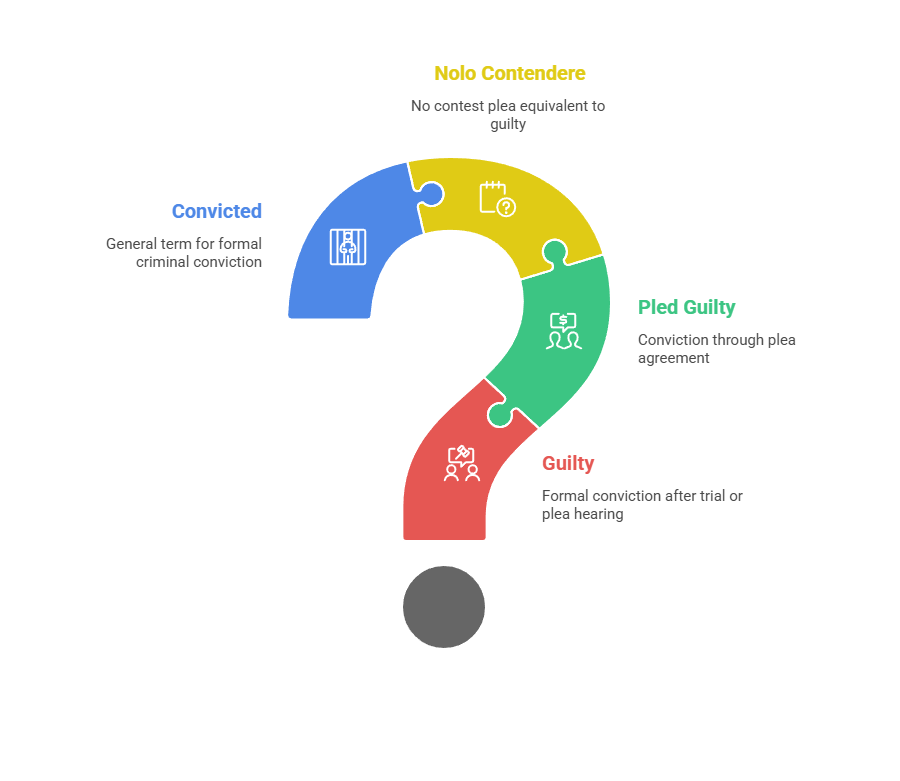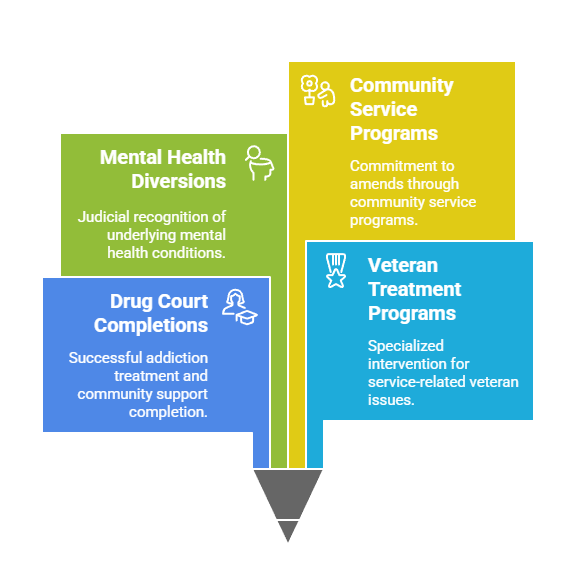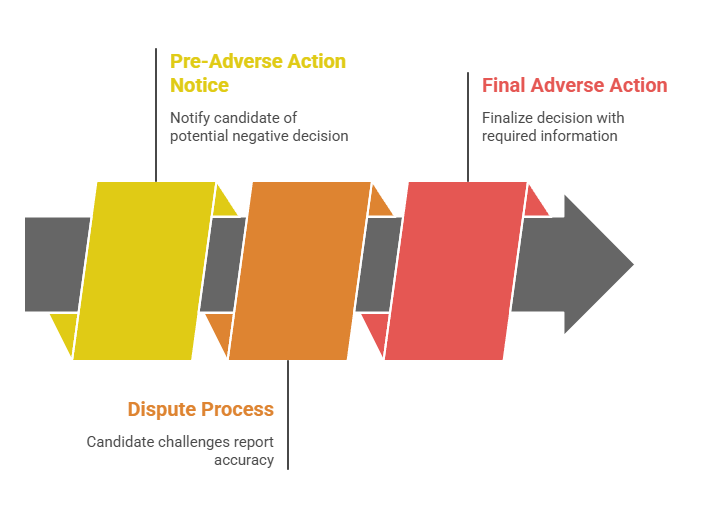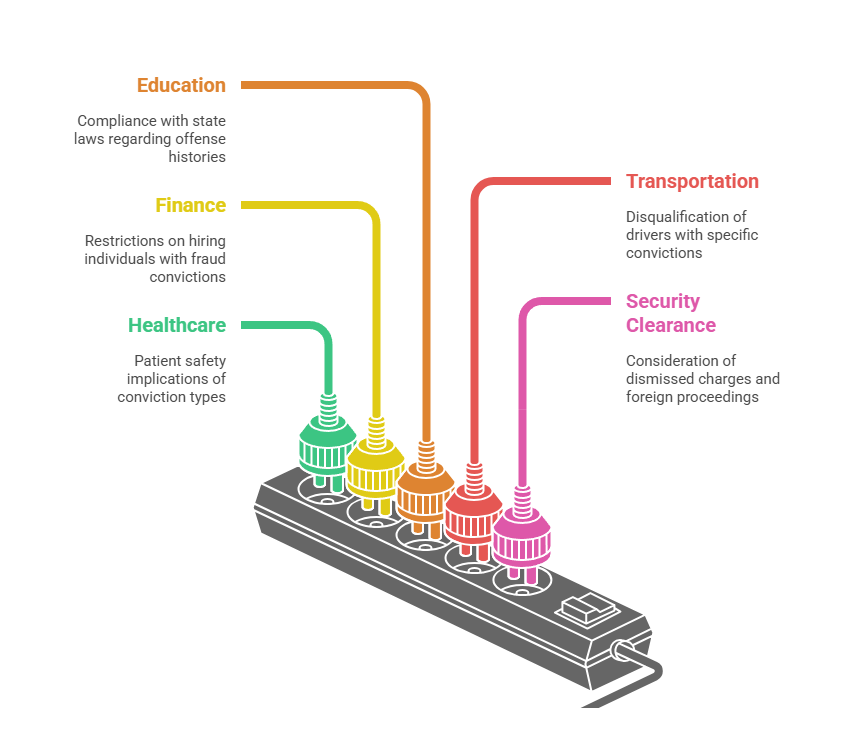Court disposition codes are standardized abbreviations that indicate the final outcome of criminal cases. Understanding these codes is essential for HR professionals conducting background checks to make informed hiring decisions while maintaining legal compliance.
Key Takeaways
- Court disposition codes represent the final resolution of criminal cases and appear on background check reports as standardized abbreviations
- Common favorable dispositions include DISM (dismissed), NOLLE (charges dropped), and NOT GUILTY verdicts that typically don't disqualify candidates
- Serious disposition codes like GUILTY, CONV (convicted), and SENT (sentenced) require careful evaluation based on job relevance and company policy
- Employment impact varies significantly by disposition type, with some codes having minimal hiring implications while others may trigger disqualification
- FCRA compliance requires providing candidates with adverse action notices when disposition codes influence hiring decisions
- Regular code interpretation training helps HR teams maintain consistency and legal compliance in background check evaluations
Understanding Court Disposition Codes in Employment Screening
Court disposition codes serve as a universal language in the criminal justice system. These codes provide standardized ways to communicate case outcomes across different jurisdictions. For HR professionals, these codes represent critical decision points in the hiring process. They reveal whether criminal charges resulted in convictions, dismissals, or other outcomes that may impact employment eligibility. Understanding the nuances between different disposition codes helps organizations make fair, legally compliant hiring decisions. Meanwhile, this knowledge protects business interests and ensures consistent evaluation standards.
The complexity of court disposition abbreviations stems from variations across state and local court systems. Most jurisdictions follow similar patterns, yet specific terminology can differ significantly. Background check companies translate these codes into readable formats for easier interpretation. However, HR professionals benefit from understanding the original court language. This knowledge enables more nuanced decision-making, especially when evaluating candidates with complex criminal histories. Furthermore, it helps when cases involve multiple charges or various case outcomes.
Modern background screening has evolved to provide more context around disposition codes. These reports now include offense details, sentencing information, and time elapsed since conviction. Additionally, many platforms offer automated interpretation features. However, the core disposition remains the most important factor in determining employment impact. Therefore, code literacy represents an essential skill for today's HR professionals in making informed hiring decisions.
Most Common Disposition Codes and Their Employment Impact
Understanding frequently encountered disposition codes helps HR teams quickly assess background check results. These codes enable organizations to maintain consistent hiring standards across all recruitment activities. Moreover, proper interpretation reduces decision-making time while ensuring compliance with employment laws.
| Disposition Code | Full Meaning | Employment Impact Rating |
| DISM/DISMISSED | Case Dismissed | Low Impact |
| GUILTY/CONV | Guilty/Convicted | High Impact |
| NOLLE/NOLPROS | Will Not Prosecute | Low Impact |
| NOT GUILTY | Not Guilty Verdict | No Impact |
| DEFERRED | Deferred Adjudication | Moderate Impact |
| EXPUNGED | Record Sealed/Expunged | No Impact |
| FTA | Failure to Appear | Low to Moderate Impact |
| PLED | Pleaded Guilty | High Impact |
| ACQUITTED | Found Not Guilty | No Impact |
| SUSPENDED | Suspended Sentence | Moderate Impact |
The employment impact rating system helps HR professionals quickly categorize disposition outcomes. However, individual circumstances always require additional consideration beyond basic code interpretation.
Favorable Disposition Codes for HR Decision-Making
Dismissed cases represent some of the most favorable outcomes for employment screening purposes. These dispositions indicate charges were dropped before reaching a conviction. DISM, DISMISSED, and similar codes typically occur when prosecutors lack sufficient evidence. They also appear when procedural errors occurred or plea agreements resulted in charge dismissals. HR professionals generally view these dispositions favorably since they don't represent criminal convictions under the law.
However, some employers consider the underlying conduct even when charges are dismissed. This consideration particularly applies to positions involving financial responsibility or public safety. The key distinction lies between dismissals due to insufficient evidence versus dismissals following successful completion of diversion programs. The latter sometimes receives more favorable treatment as evidence of rehabilitation efforts.
NOT GUILTY verdicts and acquittals represent complete legal vindication. These outcomes should have no negative employment impact under most circumstances. These dispositions indicate the justice system found insufficient evidence to prove guilt beyond a reasonable doubt. Therefore, the law legally presumes innocence in these cases. Federal and state employment laws generally prohibit discrimination based on arrests that didn't result in convictions.
Some specialized positions with security clearance requirements may still consider arrest circumstances. However, standard employment practices treat these dispositions as non-disqualifying events. Additionally, most background check policies exclude non-conviction records from hiring decisions.
Conviction-Related Disposition Codes
Guilty Verdicts and Plea Agreements
GUILTY, CONVICTED, and PLED dispositions represent formal criminal convictions. These codes carry the most significant employment implications for hiring decisions. These codes indicate the defendant either admitted guilt through a plea agreement or was found guilty after trial.

- GUILTY: Formal conviction after trial or plea hearing resulting in criminal record
- PLED GUILTY: Conviction through plea agreement with prosecution showing admission of guilt
- NOLO CONTENDERE: No contest plea that is legally equivalent to guilty plea
- CONVICTED: General term indicating formal criminal conviction with sentencing
The specific impact depends heavily on the underlying offense type. Violent crimes, theft, and fraud typically carry greater employment consequences than minor infractions.
Sentencing and Punishment Codes
Sentencing-related disposition codes provide additional context about conviction severity. SENT (sentenced), PROB (probation), and PAROLE codes indicate not only conviction but also court-imposed consequences. These codes help HR professionals gauge offense seriousness and rehabilitation progress.
| Code | Meaning | HR Consideration |
| SENT | Sentenced | Evaluate sentence length and completion |
| PROB | Probation | Check completion status and compliance |
| PAROLE | Parole Supervision | Verify current supervision status |
| FINE | Monetary Penalty Only | Usually minimal employment impact |
Successfully completed sentences often weigh more favorably than ongoing supervision requirements. This completion status demonstrates rehabilitation and legal compliance efforts.
Complex and Conditional Disposition Codes
Deferred adjudication represents a middle ground between conviction and dismissal. DEFERRED, DEF ADJ, and similar codes indicate the court postponed final judgment pending successful program completion. These dispositions create unique challenges for HR professionals since they're neither full convictions nor complete dismissals. The employment impact of deferred dispositions varies significantly by state law and program type. Some jurisdictions treat successfully completed deferrals as dismissals for employment purposes. Others consider them equivalent to convictions, requiring careful policy development.

- Drug Court Completions: Demonstrate successful addiction treatment and community support
- Veteran Treatment Programs: Show specialized intervention for service-related issues
- Mental Health Diversions: Indicate judicial recognition of underlying health conditions
- Community Service Programs: Reflect commitment to making amends through service
These specialized programs typically indicate judicial recognition of underlying issues and successful intervention. They often represent rehabilitation efforts rather than traditional criminal behavior patterns.
Appeals and Post-Conviction Actions
Appeal-related disposition codes add complexity to background check interpretation. APPEALED, REVERSED, and REMANDED codes suggest the case outcome remains unsettled or has changed since the original disposition. HR professionals should verify current case status when encountering these codes. Outdated information could lead to improper hiring decisions and potential legal liability.
REVERSED dispositions indicate higher courts overturned the original conviction. REMANDED cases return to lower courts for reconsideration with new instructions. These outcomes often result in reduced charges or complete dismissals. Therefore, they may significantly change the employment impact assessment.
Jurisdiction Variations and Special Circumstances
Different states and court systems use varying abbreviation formats for similar dispositions. This variation creates challenges for multi-state employers conducting nationwide background checks. While core concepts remain consistent, specific codes and terminology differ significantly between jurisdictions. For example, "NOLLE PROSEQUI" might appear as NOLLE, NOLPROS, or NP depending on the court system. Federal courts often use different coding systems than state courts entirely. Military justice proceedings employ separate terminology that requires specialized knowledge.
HR professionals working with diverse candidate pools should familiarize themselves with common variations. Establishing relationships with background screening vendors who provide clear code translations reduces interpretation complexity. Many modern screening platforms automatically translate jurisdiction-specific codes into standardized language. This automation helps eliminate confusion while maintaining accuracy.
Municipal and county courts sometimes use locally developed abbreviation systems. These systems don't align with state standards, particularly in smaller jurisdictions with limited technology resources. This variation underscores the importance of working with experienced background screening providers. These providers maintain comprehensive code databases and regularly update their interpretation systems. Additionally, they offer customer support for unusual or unclear dispositions.
Legal Compliance and FCRA Requirements
The Fair Credit Reporting Act mandates specific procedures when court disposition codes influence hiring decisions. Employers must provide pre-adverse action notices and opportunities for candidates to dispute inaccurate information. HR professionals must understand which dispositions trigger FCRA obligations and maintain documented decision-making processes. These processes demonstrate compliance with federal requirements and protect against discrimination claims.

- Pre-Adverse Action Notice: Required before making negative hiring decisions based on background reports
- Dispute Process: Candidates can challenge background report accuracy within specified timeframes
- Final Adverse Action: Must include specific information about rights and reporting agency contact details
Adverse action procedures become particularly important when dealing with older convictions or dismissed charges. The FCRA's dispute process allows candidates to challenge background report accuracy, potentially leading to updated information.
Ban-the-Box and Fair Chance Hiring Laws
State and local ban-the-box legislation increasingly restricts how employers can use disposition codes. Many jurisdictions prohibit consideration of certain offense types or require individualized assessments before disqualification. These laws often distinguish between conviction types, with violent felonies receiving different treatment than minor misdemeanors. Non-violent offenses frequently have shorter consideration periods or complete exclusions from hiring decisions.
Individualized assessment requirements consider job relevance, rehabilitation evidence, and time elapsed since conviction. Many laws require conditional job offers before criminal history consideration. Documentation standards require maintaining records showing compliance with fair chance requirements. Appeal processes provide mechanisms for candidates to contest adverse decisions through formal review procedures.
HR professionals must stay current with evolving fair chance legislation. New laws frequently expand protections and modify employer obligations regarding disposition code interpretation. Regular training updates ensure compliance with changing legal requirements.
Building Effective Background Check Policies

Developing comprehensive policies for disposition code interpretation ensures consistent hiring practices. Effective policies address common disposition types and establish clear decision-making criteria. They also provide guidance for handling complex or unusual codes requiring additional research. Policy frameworks should incorporate job relevance standards that connect specific disposition types to position requirements.
These standards help HR teams make objective decisions rather than subjective judgments about candidate suitability. For example, financial crimes might disqualify candidates for accounting positions but have minimal relevance for manufacturing roles. Violent offense convictions could affect customer-facing positions differently than warehouse work. Position-specific guidelines create consistency while addressing legitimate business concerns.
Training programs help HR professionals apply disposition code policies consistently. Regular policy reviews ensure organizational standards align with changing laws and industry developments. Documentation requirements create audit trails demonstrating compliant decision-making processes. These records prove valuable during regulatory reviews or legal challenges.
Technology Tools and Resources for Code Interpretation
Modern HR information systems increasingly integrate background check results with automated disposition code interpretation. These systems provide real-time guidance for hiring decisions and flag cases requiring additional review. Technology solutions help reduce human error in code interpretation while maintaining audit trails. They also ensure faster processing times and consistent application of company policies.
Database resources and reference guides provide quick access to disposition code definitions. These tools enable HR professionals to research unfamiliar codes efficiently without delays. Many background screening vendors offer online portals with integrated code lookup tools. These portals include case status tracking and automated compliance reporting features that streamline the evaluation process.
- Mobile Applications: Provide instant disposition code translations for remote access
- Browser Extensions: Offer real-time code interpretation during background review processes
- API Integrations: Connect background screening directly with HRIS systems for seamless workflows
- Compliance Dashboards: Track adherence to fair chance hiring laws and FCRA requirements
These tools prove particularly valuable for staffing agencies and distributed HR teams managing high-volume recruitment processes. They maintain security standards for sensitive candidate information while improving efficiency.
Industry-Specific Considerations

Healthcare, finance, and education industries have unique requirements for disposition code interpretation. Federal regulations often override state laws in these sectors, creating additional compliance layers. For instance, healthcare employers must consider patient safety implications of certain conviction types. Financial services companies face regulatory restrictions on hiring individuals with fraud or theft convictions. Educational institutions must comply with state laws regarding individuals with certain offense histories.
Transportation and logistics companies must consider Department of Transportation regulations. These regulations disqualify drivers with specific conviction types regardless of time elapsed. Similarly, positions requiring professional licenses may have automatic disqualification triggers. These industry-specific requirements often supersede general employment law protections.
Security clearance positions follow federal adjudication guidelines that differ significantly from standard employment practices. These positions may consider dismissed charges, arrests without conviction, and foreign legal proceedings. Understanding these specialized requirements prevents inappropriate hiring decisions and ensures regulatory compliance.
Training and Development for HR Teams
Comprehensive training programs should cover legal requirements, code interpretation, and decision-making frameworks. Regular updates address changing laws and emerging best practices in fair chance hiring. Role-playing exercises help HR professionals practice difficult scenarios and develop consistent responses. These exercises build confidence in handling complex disposition codes and candidate discussions.
Certification programs from professional organizations provide structured learning paths. The Society for Human Resource Management (SHRM) and other groups offer specialized courses. These programs include testing components that verify knowledge retention and practical application skills. Additionally, they provide continuing education credits for maintaining professional certifications.
Documentation training ensures proper record-keeping for compliance purposes. HR teams must understand what information to capture and how long to retain records. Proper documentation protects against discrimination claims and demonstrates good faith efforts at fair evaluation. It also supports organizational learning by tracking decision outcomes over time.
Quality Assurance and Audit Procedures
Regular audits of background check decisions help identify inconsistencies and training needs. These reviews should examine disposition code interpretations across different reviewers and time periods. Statistical analysis can reveal bias patterns or misapplication of company policies. Quality assurance processes ensure fair treatment of all candidates regardless of reviewer assignment.
Audit procedures should include sample reviews of hiring decisions involving various disposition types. These reviews verify appropriate application of job relevance standards and legal requirements. They also identify cases where additional training or policy clarification is needed. External audits by employment attorneys provide objective assessments of compliance levels.
Corrective action plans address identified deficiencies and prevent future problems. These plans include additional training, policy updates, and process improvements. Follow-up monitoring ensures implemented changes achieve desired outcomes. Regular reporting to senior management demonstrates commitment to fair hiring practices.
Conclusion
Mastering court disposition codes represents a fundamental skill for modern HR professionals. This knowledge directly impacts hiring quality, legal compliance, and organizational risk management. The evolving landscape of fair chance hiring laws makes code literacy increasingly important. Employers must balance public safety concerns with rehabilitation opportunities and anti-discrimination requirements. By developing comprehensive understanding of disposition meanings, employment impacts, and legal obligations, HR teams can make informed decisions. Successful implementation requires ongoing education, policy development, and technology adoption to ensure consistent, compliant practices across all hiring activities.
Frequently Asked Questions
What does DISM mean on a background check?
DISM stands for "dismissed" and indicates that criminal charges were dropped before reaching a conviction. This disposition typically has minimal employment impact since it doesn't represent a criminal conviction. However, employers should consider the underlying circumstances and job requirements when making hiring decisions.
What is the difference between NOLLE and NOT GUILTY dispositions?
NOLLE (NOLLE PROSEQUI) means prosecutors decided not to pursue charges. NOT GUILTY indicates a defendant was tried and acquitted. Both are generally favorable for employment purposes. However, NOT GUILTY represents complete legal vindication after trial. NOLLE suggests charges were dropped before trial completion.
Can employers consider dismissed charges in hiring decisions?
While dismissed charges don't constitute criminal convictions, some employers may consider the underlying conduct. This particularly applies to positions involving security, financial responsibility, or public safety. However, many states restrict or prohibit consideration of non-conviction records. Employers should consult local laws before making adverse hiring decisions based on dismissed charges.
How long do conviction dispositions affect employment eligibility?
The impact duration varies by state law, offense type, and employer policy. Many jurisdictions limit consideration of non-violent convictions to seven or ten years. Violent felonies may have longer or indefinite consideration periods. Federal positions and roles requiring security clearances often have different standards than private sector employment.
What does deferred adjudication mean for hiring purposes?
Deferred adjudication indicates a defendant completed court-supervised programs in exchange for avoiding formal conviction. The employment impact varies by state. Some treat successful completion as dismissal while others consider it equivalent to conviction. HR professionals should research local laws and company policies for consistent treatment.
Are expunged records supposed to appear on background checks?
Properly expunged records should not appear on standard background checks. The legal process seals or destroys court records. If expunged information appears, it may indicate incomplete processing or database errors. It could also mean searches accessed sealed records inappropriately. Candidates should have opportunities to address these discrepancies.
Additional Resources
- Equal Employment Opportunity Commission (EEOC) Criminal Background Check Guidance
https://www.eeoc.gov/laws/guidance/arrest-conviction-records-employment-decisions - Society for Human Resource Management (SHRM) Background Checking Resources
https://www.shrm.org/topics-tools/tools/hr-qa/background-checks - National Association of Professional Background Screeners (NAPBS)
https://www.napbs.com/ - Consumer Financial Protection Bureau (CFPB) Fair Credit Reporting Act Information
https://www.consumerfinance.gov/compliance/compliance-resources/other-applicable-requirements/fair-credit-reporting-act/ - Ban the Box Resource Center - National Employment Law Project
https://www.nelp.org/campaign/ensure-fair-chance-to-work/ - Federal Trade Commission (FTC) Background Check Guidelines for Employers
https://www.ftc.gov/tips-advice/business-center/guidance/background-checks-what-employers-need-know - American Staffing Association Background Screening Best Practices
https://americanstaffing.net/talent-acquisition/background-screening/
